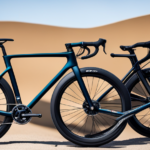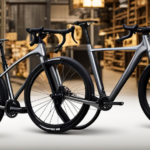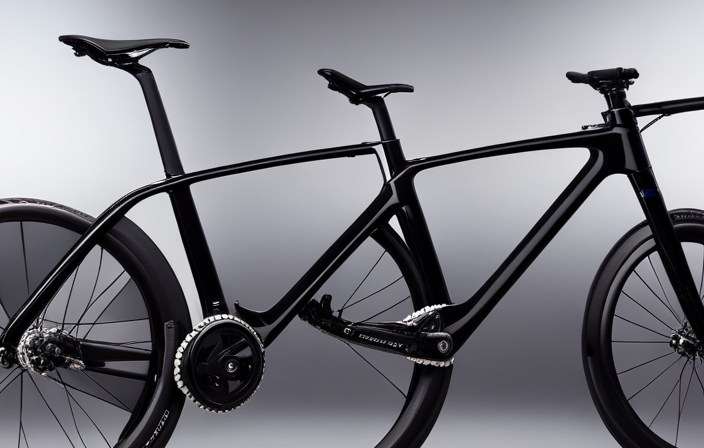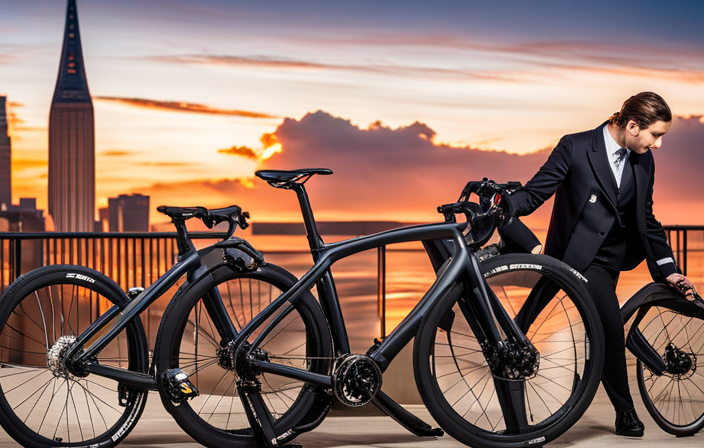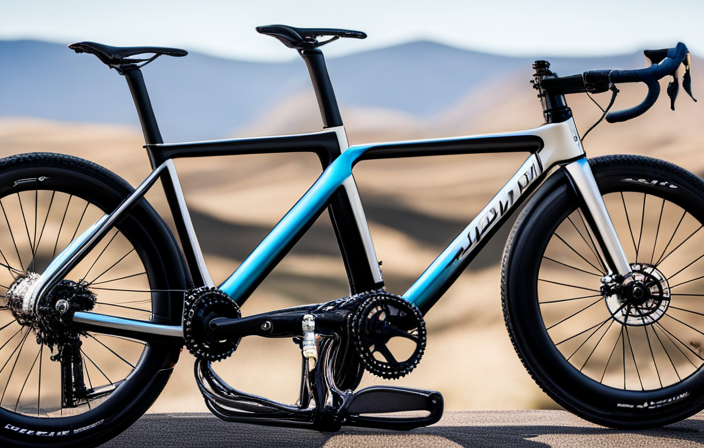Standing at the junction, with the sound of gravel underfoot, I am brought to mind of the myriad of adventures that await aboard a gravel bike.
But with so many options to choose from, how do you find the perfect one for your riding style?
In this article, we’ll delve into the key factors to consider when choosing a gravel bike.
From understanding your goals and evaluating frame materials to researching reviews and test riding different models, we’ll guide you towards finding the ultimate companion for your off-road escapades.
Key Takeaways
- Understanding your riding style and goals is crucial in choosing the right gravel bike.
- Researching and reviewing different bike models, as well as consulting experts, can help in making an informed decision.
- Considering bike specifications such as frame material, tire clearance, geometry, suspension options, and brake system is important.
- Assessing the bike’s drivetrain, wheel size, handlebars, budget, maintenance requirements, and terrain compatibility should also be taken into account.
Understand Your Riding Style and Goals
To choose the right gravel bike, you should understand your riding style and goals. Your riding preferences will play a big role in deciding what type of bike is best suited for you. Do you prefer long-distance rides or shorter, more intense bursts of speed? Are you planning to ride on mostly flat terrain or do you enjoy tackling challenging hills and rough trails? These are important questions to consider when choosing a gravel bike.
In addition to understanding your riding preferences, it’s also crucial to set clear goals for yourself. What do you hope to achieve with your gravel bike? Are you training for a specific event or just looking to stay active and explore new places? Knowing your goals will help guide your decision-making process.
By understanding both your riding style and goals, you can narrow down the options and find the perfect gravel bike that suits your needs.
Now that we have covered how to understand your riding style and goals, let’s move on to considering the bike’s frame material.
Consider the Bike’s Frame Material
When looking for a gravel bike, it’s important to consider the material of the frame. The frame material affects the bike’s weight, durability, and ride quality. There are several options available, each with their own pros and cons.
One popular frame material is aluminum. It is lightweight and affordable, making it a common choice for entry-level gravel bikes. Aluminum frames offer good stiffness and responsiveness, providing a lively ride experience. However, they can transmit more road vibrations compared to other materials.
Another option is carbon fiber. Carbon frames are known for their lightweight construction and excellent vibration damping properties. They provide a smooth and comfortable ride on rough terrains while being strong and durable. However, carbon fiber frames tend to be more expensive than aluminum ones.
Steel is another traditional frame material used in gravel bikes. Steel frames are renowned for their strength and durability. They absorb vibrations well, resulting in a comfortable ride over long distances. However, they can be heavier compared to aluminum or carbon fiber frames.
Some popular gravel bike brands that offer different frame materials include Specialized, Trek, Giant, Cannondale, and Santa Cruz.
Considering the bike’s tire clearance will further help you choose the perfect gravel bike that suits your needs seamlessly.
Determine the Bike’s Tire Clearance
If you’re considering the tire clearance of a gravel bike, it’s important to take into account your preferred tire width and the type of terrain you plan to ride on. The tire clearance refers to the amount of space between the frame and fork that can accommodate wider tires. This is crucial because it determines what size tires you can use on your bike.
When choosing a gravel bike, you need to consider the type of riding you’ll be doing. If you plan on tackling rougher terrains with loose gravel or dirt trails, then having larger tire clearance is essential. It allows for wider tires, which provide better traction and stability in challenging conditions.
Additionally, different tire widths require varying pressure levels for optimal performance. Narrower tires typically require higher pressure, while wider ones need lower pressure. Adjusting your tire pressure based on the terrain and conditions can greatly enhance your riding experience.
In conclusion, when selecting a gravel bike, carefully consider its tire clearance to ensure that it accommodates your preferred tire width and suits the type of terrain you’ll be riding on. This will allow you to make informed decisions about bike tire selection and appropriate tire pressure adjustment.
Now let’s move on to deciding on the bike’s geometry…
Decide on the Bike’s Geometry
Deciding on the bike’s geometry is an important factor to consider when selecting a gravel bike. It plays a crucial role in how comfortable and efficient your ride will be. The right geometry ensures that the bike fits you properly and offers a comfortable riding position. Bike fit is essential because an ill-fitting bike can lead to discomfort, pain, and even injuries.
When it comes to bike sizing, there are two main factors to consider: reach and stack. Reach refers to the distance between the bottom bracket and the top of the head tube, while stack represents the vertical height from the bottom bracket to the top of the head tube. These measurements determine how stretched out or upright your riding position will be.
A gravel bike with a more relaxed geometry will have a higher stack and shorter reach, providing a more upright riding position suitable for longer rides or riders who prefer comfort over speed. On the other hand, a more aggressive geometry with a lower stack and longer reach offers better aerodynamics and faster handling.
Considering your body proportions, flexibility, and intended use of the bike will help you determine which geometry suits you best. Once you’ve decided on this aspect, you can move on to evaluating the bike’s suspension options.
[Transition sentence]: Understanding how different suspension options affect gravel biking performance is crucial for making an informed decision about which one is right for you.Evaluate the Bike’s Suspension Options
To make an informed decision about which suspension option is right for you, consider evaluating the different options available for the bike’s suspension. Gravel bikes typically have three main suspension types:
-
Rigid bikes have no suspension at all, making them lightweight and efficient on smooth surfaces. However, they may lack comfort and can be less forgiving on rough terrain.
-
Front suspension bikes, also known as hardtails, feature a fork with a shock absorber in the front. This provides increased comfort and control on bumpy roads or trails.
-
Full suspension gravel bikes take it up a notch by incorporating both front and rear shocks. This offers even better shock absorption and enhanced traction.
The benefits of having some form of suspension in a gravel bike are numerous. Suspension helps to absorb impact from bumps, rocks, and uneven surfaces, reducing fatigue on long rides while increasing overall comfort. It also improves traction by keeping the tires in contact with the ground more consistently.
Now that we’ve covered evaluating the bike’s suspension options, let’s move on to assessing the bike’s brake system…
Assess the Bike’s Brake System
When assessing a bike, it’s important to consider the quality and effectiveness of its brake system. The bike’s brake system is crucial for safety and control, especially when riding on gravel terrain. There are two main types of brakes commonly found on gravel bikes: rim brakes and disc brakes.
| Brake Type | Advantages | Disadvantages |
|---|---|---|
| Rim Brakes | – Lightweight |
- Easy maintenance
- Cost-effective | – Less braking power
- Can wear down rims over time |
| Disc Brakes | – More consistent braking power - Better modulation
- Performs well in all weather conditions | – Heavier than rim brakes
- Requires more complex maintenance |
Bike brake maintenance is essential to ensure optimal performance and longevity. With rim brakes, regular inspection of the brake pads and rims is necessary to prevent excessive wear. On the other hand, disc brakes require periodic checks for pad wear and rotor alignment.
Disc brakes offer several advantages over rim brakes, making them a popular choice for many gravel riders. They provide more consistent braking power, allowing for better modulation and control in various riding conditions. Additionally, they perform well in wet or muddy environments where rim brakes may struggle.
Considering the bike’s drivetrain is the next step after assessing the brake system, as it plays a significant role in determining gear range and shifting performance.
Consider the Bike’s Drivetrain
Take into account the drivetrain of the bike when assessing its overall performance and functionality. The drivetrain is a critical component that affects how efficiently power is transferred from your legs to the wheels. It consists of several parts, including the chainrings, cassette, and derailleurs. One important factor to consider is the drivetrain efficiency. A high-quality drivetrain will have minimal friction and resistance, allowing you to pedal smoothly and transfer power more efficiently. Look for components from reputable brands known for their durability and smooth operation.
Another aspect to consider is the gear ratio options provided by the drivetrain. Gravel bikes often have a wide range of gears to accommodate various terrains, allowing you to tackle both steep climbs and fast descents comfortably. The gear ratios determine how easy or hard it is to pedal at different speeds and inclines.
Transitioning into determining the bike’s wheel size, it’s important to note that a well-designed drivetrain can greatly enhance your riding experience by providing smooth shifting and efficient power transfer. Now let’s move on to discuss another crucial aspect: determining the bike’s wheel size.
Determine the Bike’s Wheel Size
Consider the wheel size of the bike to ensure a comfortable and efficient riding experience. The bike’s wheel diameter is an important factor to consider when choosing a gravel bike. Here are some key points to keep in mind:
-
Versatility: A larger wheel diameter, such as 700c, offers better rolling efficiency on smooth surfaces and allows for higher speeds. On the other hand, smaller wheels like 650b provide more maneuverability and stability on rougher terrains.
-
Terrain: Consider the type of terrain you’ll be riding on most frequently. If you’ll be tackling rougher trails with loose gravel or uneven surfaces, opting for smaller wheels can enhance your control and stability.
-
Choosing tire width: The width of your tires also plays a crucial role in determining comfort and performance. Wider tires provide better traction, shock absorption, and stability on uneven surfaces. They are suitable for off-road adventures but may sacrifice some speed on smoother roads.
Considering these factors will help you find the right balance between speed, control, and comfort based on your riding preferences and the terrain you plan to conquer.
Next, we will evaluate the bike’s handlebars to ensure optimal handling and control without compromising comfort.
Evaluate the Bike’s Handlebars
To ensure optimal handling and control without compromising comfort, evaluate the handlebars of your potential bike.
The handlebar options available for gravel bikes are diverse, each offering distinct benefits depending on your preferences and riding style.
Drop bars are a popular choice among gravel riders due to their versatility and aerodynamic advantages. They provide multiple hand positions, allowing you to easily switch between upright cruising and aggressive descents.
Flat bars, on the other hand, offer a more upright riding position that provides better control and maneuverability in technical terrains. They also give you a wider grip for added stability during off-road adventures.
Another option is the flared drop bars which combine the benefits of both drop and flat bars by offering a wider stance for improved stability while still maintaining an aerodynamic profile.
Considering the bike’s weight, it is important to find a balance between durability and lightweight construction. This will ensure that you can easily navigate through rough terrain while still having a bike that is manageable in terms of weight.
Consider the Bike’s Weight
The weight of the bike is an important factor to keep in mind when evaluating its overall performance. A lighter bike can offer advantages such as increased maneuverability and faster acceleration.
Here are a few key points to consider regarding bike weight:
- Efficiency: A lighter gravel bike allows for easier pedaling, reducing fatigue during long rides or challenging terrains.
- Climbing: Less weight means less effort required to climb hills or conquer steep inclines, improving your ability to tackle difficult routes.
- Responsiveness: Lighter bikes tend to be more responsive, making it easier to control and navigate through various surfaces.
Weight distribution is another aspect to take into account. Ideally, the weight should be evenly distributed between the front and rear of the bike. This helps maintain stability and balance while riding on uneven terrain.
Considering both the overall weight of the gravel bike and its weight distribution will contribute to a more enjoyable riding experience.
Now let’s move on to evaluating the next aspect – the bike’s price range – which plays a crucial role in finding the perfect gravel bike for you.
Evaluate the Bike’s Price Range
Now let’s take a look at the cost range for the bike. When choosing a gravel bike, it is important to consider your budget and what you are willing to spend. The price of gravel bikes can vary greatly depending on the brand, components, and overall quality. To help you make an informed decision, I have created a comparison table below showcasing different price ranges and their corresponding features.
| Price Range | Features |
|---|---|
| $500-$1000 | Entry-level gravel bikes with basic components and aluminum frames. Suitable for beginners or those on a tight budget. |
| $1000-$2000 | Mid-range options with better components and potentially carbon frames. These bikes offer improved performance and durability. |
| $2000+ | High-end gravel bikes with top-tier components, carbon frames, and advanced technology. These bikes are designed for serious riders who demand the best. |
When considering the bike’s price range, it is essential to evaluate your budget considerations and determine how much you are willing to invest in this sport. Keep in mind that while more expensive bikes generally offer better performance and higher quality materials, there are still excellent options available within lower price ranges.
Understanding the bike’s cost range is just one aspect of choosing a gravel bike. Next, we will discuss another important step: researching and reading reviews to gather more information about specific models before making your final decision.
Research and Read Reviews
Researching and reading reviews is crucial in gathering more information about specific models before making a final decision on which bike to purchase. It allows you to gain insights from other cyclists who have already experienced the bike brands you are considering. Reading reviews can provide valuable information about the quality, performance, durability, and overall satisfaction of different bikes.
Here are three reasons why researching and reading reviews is important:
-
Comparisons: Reviews allow you to compare different gravel bikes within your budget considerations. You can see how they stack up against each other in terms of features, components, and value for money.
-
Pros and Cons: By reading reviews, you can learn about the strengths and weaknesses of various models. This helps you identify which aspects are most important to you and make an informed decision based on your own preferences.
-
Real User Experiences: Reviews often include personal anecdotes and real-life experiences from cyclists who have actually ridden the bikes. This gives you a better understanding of how the bike performs in different conditions.
By thoroughly researching and reading reviews, you can narrow down your options and make a more informed choice when it comes time to test ride different models.
Test Ride Different Models
Once you’ve gathered information from reviews, it’s important to test ride different models to get a feel for their performance and comfort. The test ride experience is crucial in determining whether a gravel bike suits your needs. When trying out different bikes, pay attention to how they handle on various terrains such as gravel roads or rough trails. Notice if the bike feels stable and responsive or sluggish and unsteady. Additionally, consider how the bike fits your body and provides comfort during the ride. A properly fitted bike will ensure that you maintain good posture and avoid any unnecessary strain on your joints.
During the test ride, take note of any discomfort or pressure points that arise, especially in areas like the saddle or handlebars. These can be adjusted later with customization options but should still be taken into consideration when choosing a gravel bike model. Remember that everyone’s preferences may differ when it comes to fit and comfort, so it’s essential to find a bike that suits your unique needs.
In conclusion, testing out different models allows you to experience firsthand how each performs and evaluate their level of comfort. By paying attention to the test ride experience and considering factors such as bike fit and comfort, you can make an informed decision about which gravel bike is right for you.
Moving forward into considering customization options…
Consider Customization Options
When considering customization options, it’s important to explore different ways to personalize your gravel bike. This will help you best suit your preferences and needs. Customizing your bike not only allows you to add a personal touch, but it also provides numerous benefits that enhance your riding experience.
Here are some key benefits of customization:
- Improved comfort: You can adjust the handlebar height, saddle position, and stem length to ensure optimal comfort during long rides.
- Enhanced performance: Customizing components like tires, gears, and brakes can greatly improve the bike’s performance on various terrains.
- Increased durability: Upgrading certain parts with higher quality materials can make your bike more durable and reliable in challenging conditions.
- Unique aesthetics: Personalize the appearance of your bike by choosing custom paint colors or adding decals that reflect your style and personality.
- Tailored fit: By selecting frame sizes and geometries that match your body proportions, you can achieve a more comfortable and efficient riding position.
Considering these customization benefits, it’s important to explore the available options before making any final decisions. Consulting with a bike expert or shop can provide valuable insights into which modifications will work best for you.
Consult with a Bike Expert or Shop
After considering the customization options for your gravel bike, it’s time to take the next step and consult with a bike expert or visit a reputable bike shop. This is an essential part of the decision-making process as it allows you to tap into the knowledge and experience of professionals who are well-versed in all things related to gravel bikes.
Seeking advice from a bike expert has numerous benefits. They can provide valuable insights on different brands, models, and components that would best suit your needs and preferences. By discussing your riding style, terrain preferences, and budget with them, they can help narrow down your options and steer you towards the most suitable choices.
Bike experts have extensive knowledge on frame materials, drivetrain systems, wheel sizes, suspension options, and other technical aspects that may affect your riding experience. They can explain these features in detail and guide you through the pros and cons of each option.
Furthermore, consulting with a professional not only helps ensure that you make an informed decision but also gives you peace of mind knowing that you’ve received expert advice tailored specifically to your requirements. So don’t hesitate to reach out to a bike expert or visit a trusted bike shop – their expertise will be instrumental in choosing the perfect gravel bike for you.
Frequently Asked Questions
Are gravel bikes suitable for long-distance touring?
Yes, gravel bikes are suitable for long-distance touring. They excel in various terrains and offer several advantages for touring.
With their sturdy frame and wide tires, they provide stability and comfort on rough roads.
Gravel bikes also have mounting points for racks and panniers, allowing you to carry all your gear efficiently.
Additionally, their versatility allows you to explore both paved and unpaved routes, making them an ideal choice for long-distance gravel races or adventurous touring experiences.
Can I use a gravel bike for commuting to work?
Yes, you can definitely use a gravel bike for commuting to work. While some may argue that a road bike is more suitable, gravel bikes have their own advantages.
They offer more versatility with wider tires and better stability on rough roads or unpaved paths. The pros of using a gravel bike for commuting include the ability to handle different terrains and the option to add racks or fenders for carrying items.
However, they might be slightly slower on paved surfaces compared to road bikes.
How do I choose the right size of gravel bike?
To choose the right size of gravel bike, it is crucial to consider two key factors: selecting the appropriate frame and measuring your inseam correctly.
The frame size determines the overall fit and comfort of the bike, while an accurate inseam measurement ensures proper leg extension for efficient pedaling.
To determine frame size, consult a sizing chart provided by the manufacturer or seek assistance from a professional at a local bike shop.
Are there any specific maintenance requirements for gravel bikes?
Gravel bike maintenance is crucial to ensure optimal performance and longevity. Essential tasks include regularly cleaning and lubricating the drivetrain, checking and adjusting tire pressure, and inspecting for any damage or wear.
Additionally, it’s important to regularly clean and maintain tubeless tires as they offer several advantages for gravel biking. They provide better traction, reduce the risk of flats, and allow for running lower pressures for a smoother ride. However, they require careful installation and periodic sealant top-ups to prevent air leakage.
What accessories should I consider for my gravel bike?
When it comes to accessories for your gravel bike, there are a few must-haves that will enhance your riding experience.
First, consider bikepacking gear like frame bags and saddle packs, which provide ample storage for long rides.
Additionally, investing in a good set of tools is essential for any gravel rider. Must-have tools include a multi-tool with various wrench sizes, tire levers, and a mini pump or CO2 inflator.
These accessories will ensure you’re prepared for any adventure on your gravel bike.
Conclusion
Well, after all that research and decision-making, I finally chose my gravel bike. It’s amazing how much thought goes into something as seemingly simple as a bike.
But hey, now I can proudly say that I am the proud owner of a two-wheeled gravel machine. And let me tell you, it’s worth every second spent pondering tire clearance and suspension options.
So if you’re looking for a new gravel bike, just remember to enjoy the process and embrace the irony of spending so much time choosing something that ultimately brings us back to our childhood joy of riding bikes.
Happy pedaling!




